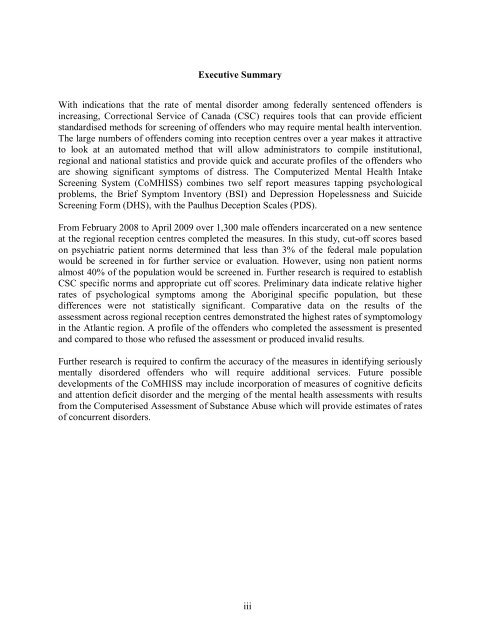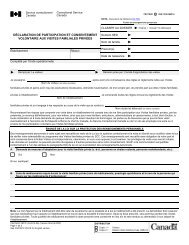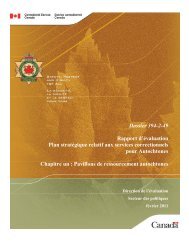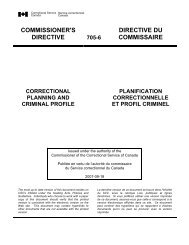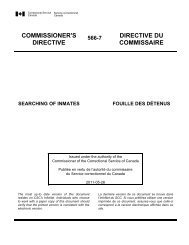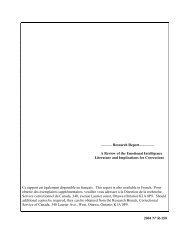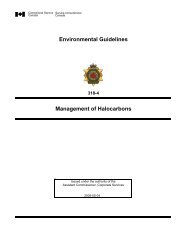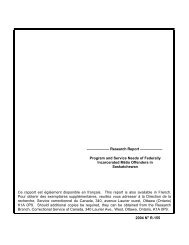The Brief Symptom Inventory (BSI) - Service correctionnel du Canada
The Brief Symptom Inventory (BSI) - Service correctionnel du Canada
The Brief Symptom Inventory (BSI) - Service correctionnel du Canada
Create successful ePaper yourself
Turn your PDF publications into a flip-book with our unique Google optimized e-Paper software.
Executive Summary<br />
With indications that the rate of mental disorder among federally sentenced offenders is<br />
increasing, Correctional <strong>Service</strong> of <strong>Canada</strong> (CSC) requires tools that can provide efficient<br />
standardised methods for screening of offenders who may require mental health intervention.<br />
<strong>The</strong> large numbers of offenders coming into reception centres over a year makes it attractive<br />
to look at an automated method that will allow administrators to compile institutional,<br />
regional and national statistics and provide quick and accurate profiles of the offenders who<br />
are showing significant symptoms of distress. <strong>The</strong> Computerized Mental Health Intake<br />
Screening System (CoMHISS) combines two self report measures tapping psychological<br />
problems, the <strong>Brief</strong> <strong>Symptom</strong> <strong>Inventory</strong> (<strong>BSI</strong>) and Depression Hopelessness and Suicide<br />
Screening Form (DHS), with the Paulhus Deception Scales (PDS).<br />
From February 2008 to April 2009 over 1,300 male offenders incarcerated on a new sentence<br />
at the regional reception centres completed the measures. In this study, cut-off scores based<br />
on psychiatric patient norms determined that less than 3% of the federal male population<br />
would be screened in for further service or evaluation. However, using non patient norms<br />
almost 40% of the population would be screened in. Further research is required to establish<br />
CSC specific norms and appropriate cut off scores. Preliminary data indicate relative higher<br />
rates of psychological symptoms among the Aboriginal specific population, but these<br />
differences were not statistically significant. Comparative data on the results of the<br />
assessment across regional reception centres demonstrated the highest rates of symptomology<br />
in the Atlantic region. A profile of the offenders who completed the assessment is presented<br />
and compared to those who refused the assessment or pro<strong>du</strong>ced invalid results.<br />
Further research is required to confirm the accuracy of the measures in identifying seriously<br />
mentally disordered offenders who will require additional services. Future possible<br />
developments of the CoMHISS may include incorporation of measures of cognitive deficits<br />
and attention deficit disorder and the merging of the mental health assessments with results<br />
from the Computerised Assessment of Substance Abuse which will provide estimates of rates<br />
of concurrent disorders.<br />
iii


